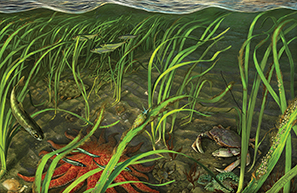As a boater, you can have a great impact on eelgrass. Although it may just look like a grassy field growing underwater, an eelgrass meadow is brimming with life. Your propeller, anchor or crab pot can quickly harm and even destroy an eelgrass meadow.
The eelgrass meadow is used as a nursery by perch, crab, salmon, and Pacific herring. Juvenile salmon use eelgrass beds as a protective location to hide from predators, grow, and feed. Eelgrass meadows can cushion the impact of currents and waves, trapping sediments and protecting against erosion. When eelgrass leaves die they break down, providing food for worms, shellfish, and sea stars.
Eelgrass grows in locations without strong wave action and good water clarity on sandy and muddy bottoms from the intertidal zone down to a depth of about 35 feet. The leaves are long and slender, measuring about a half inch in width and up to 3 feet long.
- Slowing down or stopping when cruising over eelgrass. Propellers can cut eelgrass and boat wakes can disturb the sediment that protects the root system.
- Avoiding anchoring over eelgrass beds. Anchors hold poorly in eelgrass, tear out eelgrass when pulled up, and the chain acts like a slow moving weed trimmer as the boat rotates around the anchor below.
- Avoiding dropping crab pots into eelgrass beds. Eelgrass will wrap around your crab pot rope and trap, tearing out eelgrass as you retrieve the trap and make a mess on the deck of your boat.
- Installing mooring buoys correctly. Rotating mooring chains scour eelgrass habitat. DNR must approve mooring buoys and other agencies may also require authorization.
